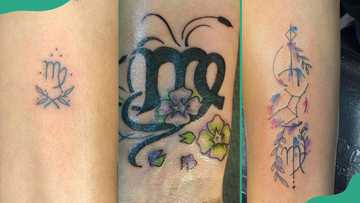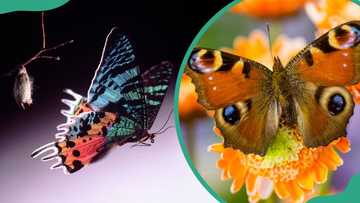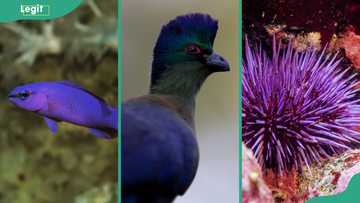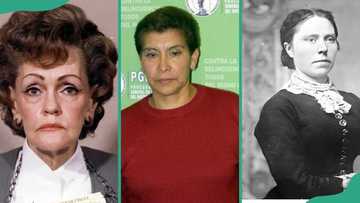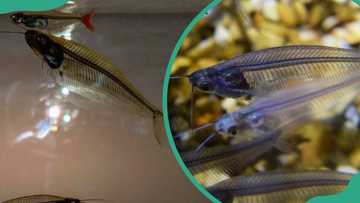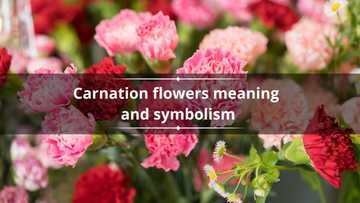What are Merle dogs? 20 breeds and what you should know about them
Merle dogs are breeds of dogs with mottled patches of color in a solid or piebald coat. Many canine owners consider these dogs quite attractive because of their beautiful coloration. They are characterised mainly by their patched skin colour on their nose or paw pads and blue or possibly odd–coloured eyes. Here are Merle dog breeds and exciting facts about them. Jerold Bell, a Professor of Clinical Genetics at Tufts University, shares insights on what makes the merle coat pattern unique, and other important health information for dog owners.

Source: Getty Images
TABLE OF CONTENTS
- How would you define the merle coat pattern in dogs, and what distinguishes it from other coat patterns?
- Expert Tips
- Merle dog breeds
- 1. Australian Shepherd
- 2. Border Collie
- 3. Dapple Dachshund
- 4. Shetland Sheepdog
- 5. Cardigan Welsh Corgi
- 6. Great Dane
- 7. Dachshund
- 8. Chihuahua
- 9. Lancashire Heeler
- 10. Catahoula Leopard Dog
- 11. Pyrenean Shepherd
- 12. Australian Koolie
- 13. Bergamasco Shepherd
- 14. Rough Collie
- 15. Smooth Collie
- 16. French Bulldog
- 17. Beauceron
- 18. Pomeranian
- 19. Mudi
- 20. American Bully
- Are Merle dogs inbred?
- Do Merle dogs have health problems?
- What causes a dog to be a Merle?
- Why are Merle dogs more expensive?
- Why can't two Merles breed?
Merle dog breeds have distinctive coat patterns due to the presence of the “Merle” gene. Merle coats result from a mutated gene that produces less melanin in some parts of a dog’s skin and fur. These Merle dog breeds have many coat colors, including red, blue, chocolate, and fawn.
How would you define the merle coat pattern in dogs, and what distinguishes it from other coat patterns?
Jerold Bell, a Professor of Clinical Genetics at Tufts University, explained in an interview that the merle coat pattern is defined as irregular spots of fur set against a lighter background of the same pigment, such as solid black on gray (blue merle) or solid brown on tan (red merle). He said:
It is caused by diluting the melanin pigment cells in the skin. The Merle gene can also cause blue eyes. In some breeds, a merle is called a dapple coat pattern.
Merle is inherited dominantly, so one copy of the Merle gene causes the coat color pattern. The degree of expression of the Merle coat pattern varies based on the length of the mutated gene being carried by the dog (which changes with each generation).
Some dogs have the pattern over the entire body, some in patches, and some do not show the coat pattern (cryptic merles) but pass the gene to their offspring. Dogs carrying the Merle gene, especially dogs with two copies of the Merle gene, can have congenital disabilities involving the eyes (microphthalmia and undeveloped eyes) and ears (congenital unilateral or bilateral deafness).
Expert Tips
Professor Bell also shared some care and health considerations about merle-patterned dogs for prospective owners. He emphasized:
Due to the high risk of producing puppies with eye and hearing congenital disabilities, especially in dogs with two copies of the gene, breeding two merle dogs together is not recommended. Merle dogs without eye or hearing issues at birth will not develop them later on as related to the Merle gene. (Any dog can develop other hereditary or environmental (non-hereditary) eye or hearing issues during their lifetime).
Merle dog breeds
Dogs are man’s best friend, and you might find a perfect companion in one of the many wonderful Merle dog breeds. Check them out below to discover what makes each dog breed stand out.
| Breed | Origin |
| Australian Shepherd | United States |
| Border Collie | United Kingdom (England and Scotland) |
| Dapple Dachshund | Germany |
| Shetland Sheepdog | Scotland (Shetland Islands) |
| Cardigan Welsh Corgi | Wales |
| Great Dane | Germany |
| Dachshund | Germany |
| Chihuahua | Mexico |
| Lancashire Heeler | England |
| Catahoula Leopard Dog | United States (Louisiana) |
| Pyrenean Shepherd | France |
| Australian Koolie | Australia |
| Bergamasco Shepherd | Italy |
| Rough Collie | Scotland |
| Smooth Collie | Scotland |
| French Bulldog | France |
| Beauceron | France |
| Pomeranian | Germany |
| Mudi | Hungary |
| American Bully | United States |
1. Australian Shepherd

Source: Getty Images
- Origin: United States
- Height: 18 – 23 inches (46 – 58 centimeters)
- Weight: 35 – 70 pounds (16 – 32 kg)
- Life expectancy: 12 – 15 years
- Coat colors: Blue, red, black, all with or without white markings
Australian Shepherd Merle dogs originated from the United States in the late 1800s. These canines are trainable and enjoy bonding with their human family. They are active and love playing with kids and adults. Their life expectancy ranges between 12 to 15 years.
2. Border Collie

Source: Getty Images
- Origin: United Kingdom (England and Scotland)
- Height: 18 – 22 inches (46 – 56 centimeters)
- Weight: 30 – 55 pounds (14 – 25 kg)
- Life expectancy: 12 – 15 years
- Coat colors: Black and white, blue, red, and other color combinations
Border Collies have white coats with darker patches on them. This canine stands about 18 to 22 inches (46 – 56 centimeters) tall and weighs 30 – 55 pounds (14 – 25 kg). Border Collies breed excels at dog sports, including herding, nose work, agility, obedience, tracking, and dock diving.
3. Dapple Dachshund

Source: Getty Images
- Origin: Germany
- Height: 8 – 9 inches (20 – 23 centimeters)
- Weight: 16 – 32 pounds (7 – 14 kg)
- Life expectancy: 12 – 16 years
- Coat colors: Red, cream, black and tan, chocolate and tan, blue and tan
Dapple Dachshund is also nicknamed “sausage dog,” “wiener dog,” “dotson,” and “doxie.” These canines have a long history as working dogs, bred to hunt and catch prey underground. Their life span ranges between 12 to 16 years.
4. Shetland Sheepdog

Source: Getty Images
- Origin: Scotland (Shetland Islands)
- Height: 13 – 16 inches (33 – 41 centimeters)
- Weight: 15 – 25 pounds (7 – 11 kg)
- Life expectancy: 12 – 14 years
- Coat colors: Blue, sable, black, all with white and tan markings
Shetland Sheepdogs are one of the most biddable canines you can have. They are intelligent, easy to train and succeed in almost everything they try. These canines are used as medical alert, service and therapy dogs. They originate from the Shetland Islands in Scotland, where they got their name.
5. Cardigan Welsh Corgi

Source: Getty Images
- Origin: Wales
- Height: 10.5 – 12.5 inches (27 – 32 centimeters)
- Weight: 25 – 38 pounds (11 – 17 kg)
- Life expectancy: 12 – 15 years
- Coat colors: Blue Merle, brindle, black and white, red, sable
The Cardigan Welsh Corgi breeds are naturally attentive, making them excellent watchdogs. Their height ranges between 10.5 to 12.5 inches (27 – 32 centimeters). These canines’ coat colors may be blue Merle, brindle, black and white, red, or sable. They originate from Wales and have a lifespan of 12 to 15 years.
6. Great Dane

Source: Getty Images
- Origin: Germany
- Height: 28 – 34 inches (71 – 86 centimetres)
- Weight: 110 – 175 pounds (50 – 79 kg)
- Life expectancy: 7 – 10 years
- Coat colors: Blue, black, fawn, brindle, harlequin, mantle, Merle
The Great Dane is a friendly giant known for its imposing size. Their height ranges from 28 to 34 inches (71 – 86 centimeters) and can weigh between 110 to 175 pounds (50 – 79 kg). Coat colors include blue, black, fawn, brindle, harlequin, mantle, and Merle.
7. Dachshund

Source: Getty Images
- Origin: Germany
- Height: 8 – 9 inches (20 – 23 centimeters)
- Weight: 16 – 32 pounds (7 – 14 kg)
- Life expectancy: 12 – 16 years
- Coat colors: Red, cream, black and tan, chocolate and tan, blue and tan
Dachshunds are excellent hunters and companions. They stand 8 to 9 inches (20 – 23 centimeters) tall and weigh between 16 to 32 pounds (7 – 14 kg). These dogs originate from Germany and do not tend to shed much.
8. Chihuahua

Source: Getty Images
- Origin: Mexico
- Height: 5 – 8 inches (13 – 20 centimeters)
- Weight: Up to 6 pounds (2.7 kg)
- Life expectancy: 14 – 16 years
- Coat colors: Any color or combination, including Merle
Chihuahuas are small and confident canines originating from Mexico. They are 5 to 8 inches (13 – 20 centimeters) tall and weigh up to 6 pounds (2.7 kg). Only 2% of Chihuahuas are Merle, making them highly sought–after.
9. Lancashire Heeler
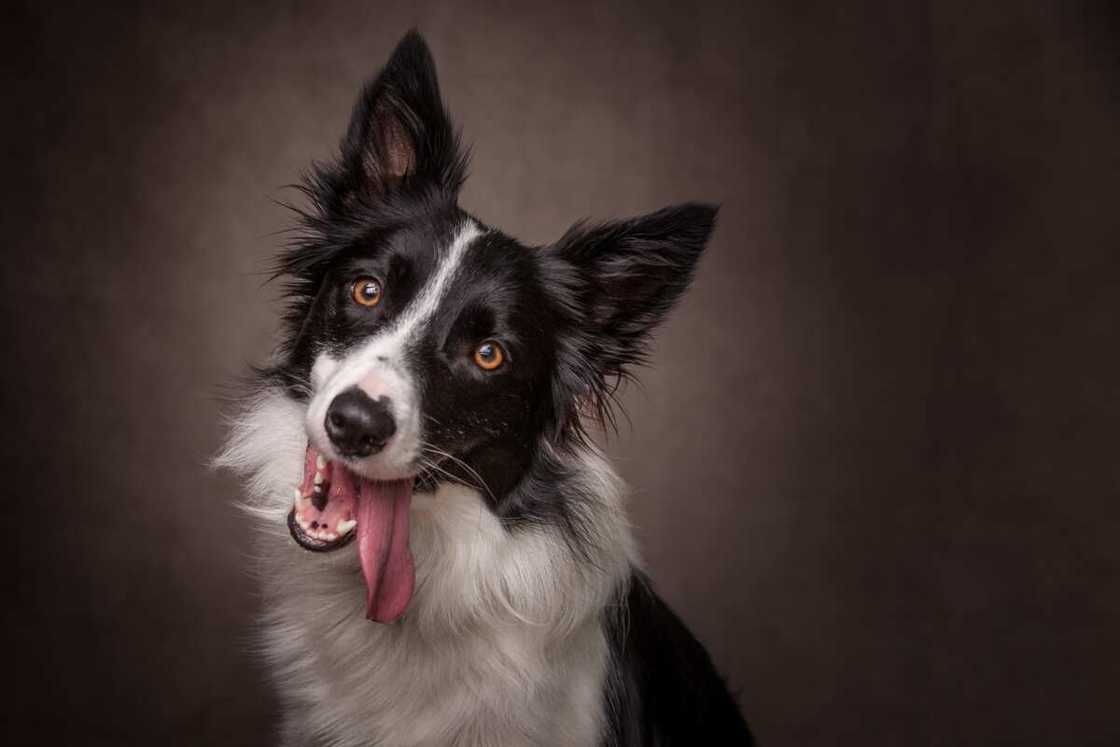
Source: Getty Images
- Origin: England
- Height: 10 – 12 inches (25 – 30 centimeters)
- Weight: 6 – 13 pounds (3 – 6 kg)
- Life expectancy: 12 – 15 years
- Coat colors: Black and tan, liver and tan, or merle
The Lancashire Heeler is a small yet versatile herding breed known for its intelligence and cheerful disposition. They stand between 10 to 12 inches (25 – 30 centimeters) tall and weigh 6 to 13 pounds (3-6 kg). These canines have a lifespan of 12 to 15 years.
10. Catahoula Leopard Dog

Source: Getty Images
- Origin: United States (Louisiana)
- Height: 22 – 24 inches (56 – 61 centimeters)
- Weight: 50 – 95 pounds (23 – 43 kg)
- Life expectancy: 10 – 14 years
- Coat colors: Blue Merle, red Merle, brindle, black, yellow, and white patches
The Catahoula Leopard Dogs are versatile and energetic canines for hunting and herding. They are known for being severe while working and playful at home. Are Catahoulas aggressive towards other dogs? The majority of Catahoula males can display aggression towards other male dogs.
11. Pyrenean Shepherd

Source: UGC
- Origin: France
- Height: 15 – 21 inches (38 – 53 centimeters)
- Weight: 15 – 32 pounds (7 – 14.5 kg)
- Life expectancy: 15 – 17 years
- Coat colors: Fawn, Merle, brindle, black, grey, and various shades
Pyrenean Shepherds are agile and intelligent, making them excellent herding dogs. They stand 15 to 21 inches (38 – 53 centimeters) tall and weigh between 15 to 30 pounds (7 – 14 kg). Their coat can be fawn, Merle, brindle, grey, or black.
12. Australian Koolie

Source: Getty Images
- Origin: Australia
- Height: 15 – 23 inches (38 – 58 centimeters)
- Weight: 30 – 55 pounds (14 – 25 kg)
- Life expectancy: 12 – 18 years
- Coat colors: Blue Merle, red Merle, black, red, combinations with white and tan markings
Australian Koolie Merle dogs usually have red or black Merle patterns on their coat. These canines are known for their speed and stamina, herding sheep and driving cattle. Their life expectancy ranges between 12 to 18 years.
13. Bergamasco Shepherd

Source: UGC
- Origin: Italy
- Height: 22 – 24 inches (56 – 61 centimeters)
- Weight: 57 – 84 pounds (26 – 38 kg)
- Life expectancy: 13 – 15 years
- Coat colors: Black, grey, Merle, any shade of grey
Bergamasco Shepherds are naturally inclined to guard and herd. They are known for their distinctive matted coats. These animals stand 22 to 24 inches (56 – 61 centimeters) tall and weigh between 57 to 84 pounds (26 – 38 kg). Their coat colors include shades of grey, Merle, and black.
14. Rough Collie

Source: Getty Images
- Origin: Scotland
- Height: 22 – 26 inches (56 – 66 centimeters)
- Weight: 50 – 75 pounds (23 – 34 kg)
- Life expectancy: 12 – 14 years
- Coat colors: Sable and white, tricolor, blue Merle, and white
The Rough Collie is known for being strong, responsive, fast, loyal and affectionate. They are a loyal and intelligent breed with a beautiful long coat flowing as they run. These animals can do well in the country or the city but need companionship and daily runs or long walks. Rough Collies originate in Scotland and can live for 12 to 14 years.
15. Smooth Collie

Source: Getty Images
- Origin: Scotland
- Height: 22 – 26 inches (56 – 66 centimeters)
- Weight: 40 – 70 pounds (18 – 32 kg)
- Life expectancy: 12 – 14 years
- Coat colors: Sable and white, tricolor, blue Merle, and white
Smooth Collies are similar to their rough–coated cousins but have a short, dense coat. They stand 22 to 26 inches (56 – 66 centimeters) tall and weigh between 40 to 70 pounds (18 – 32 kg). These canines are also easily trainable and devoted to their owners.
16. French Bulldog

Source: Getty Images
- Origin: France
- Height: 11 – 12 inches (28 – 31 centimeters)
- Weight: Under 28 pounds (13 kg)
- Life expectancy: 10 – 12 years
- Coat colors: Brindle, fawn, white, cream, and various combinations
French Bulldogs are among the Frenchie world's most distinct and unique-looking dogs. They are small, muscular, and known for their bat-like ears and affectionate nature. These cute animals have a light base coat with darker mottled patches all around their bodies. Their average lifespan typically ranges between 10 to 12 years.
17. Beauceron

Source: Getty Images
- Origin: France
- Height: 24 – 27.5 inches (61 – 70 centimeters)
- Weight: 70 – 110 pounds (32 – 50 kg)
- Life expectancy: 10 – 12 years
- Coat colors: Black and tan, harlequin (blue Merle with tan markings)
The Beauceron is a large breed, averaging between 24 – 27.5 inches (61 – 70 centimeters) in height. This breed is most distinguished by its long tail and double dewclaws. Their coat colors include black and tan and harlequin (blue Merle with a tan).
18. Pomeranian

Source: UGC
- Origin: Germany
- Height: 6 – 7 inches (15 – 18 centimeters)
- Weight: 3 – 7 pounds (1.4 – 3.2 kg)
- Life expectancy: 12 – 16 years
- Coat colors: Any color or pattern, including Merle
Pomeranians are small and lively canines known for their fluffy coats and bold personalities. They stand 6 to 7 inches (15 – 18 centimeters) tall and weigh between 3 to 7 pounds (1.4 – 3.2 kg). Pomeranians originate from Germany and Poland and have 12 to 16 years of lifespan.
19. Mudi

Source: UGC
- Origin: Hungary
- Height: 15 – 19 inches (38 – 48 centimeters)
- Weight: 18 – 29 pounds (8 – 13 kg)
- Life expectancy: 12 – 14 years
- Coat colors: Black, white, fawn, brown, grey, Merle
Mudis are one of the few breeds that can have a Merle pattern on their coat. These canines are medium-sized dogs according to their height and weight. Their coat is dense and glossy and typically has a color variation of black, white, fawn, brown, grey, or Merle.
20. American Bully

Source: Getty Images
- Origin: United States
- Height: 13 – 21 inches (33 – 53 centimeters)
- Weight: 70 – 120 pounds (32 – 54 kg)
- Life expectancy: 10 – 12 years
- Coat colors: Any color or pattern, including Merle
The American Bully is a muscular and confident breed known for its loyalty and affectionate nature. Due to their strength and potential aggression, these breeds are increasingly facing bans and restrictions. Their coat colors include a wide variety, including Merle.
Professor Bell said the merle gene appears in several dog breeds, such as the Miniature American Shepherd. He also shared:
There are other breeds where breeders have introduced the merle gene through crossbreeding to other breeds. One such breed is the French bulldog, where the merle gene/coat pattern is rapidly increasing in popularity, although it is not an accepted coat color in the breed standard.
Are Merle dogs inbred?
Merle dogs are not inherently inbred. However, the Merle gene has specific genetic considerations that can impact breeding practices.
Do Merle dogs have health problems?
If a Merle dog inherits two copies of the Merle gene (MM), known as "double Merles," there is an increased risk of some health issues, including deafness, vision issues, and skin sensitivity.
What causes a dog to be a Merle?
The Merle coat pattern is caused by a specific genetic mutation in the PMEL (premelanosome protein) gene. This mutation affects the distribution and pigmentation of the dog's coat, resulting in a mottled or patchy appearance.
Why are Merle dogs more expensive?
Merle dog breeds might cost up to $3,000. Many dog lovers are willing to pay more to get Merle dogs because the Merle pattern is relatively rare.
Why can't two Merles breed?
It can result in puppies with two copies of the Merle gene (MM). These "double Merle" dogs are at high risk for serious health issues, including deafness, blindness, and other eye defects.
These Merle dog breeds are highly sought after by dog lovers because of their distinctive and beautiful coat patterns. In addition to their striking appearances, these dog breeds possess strong working instincts, intelligence, and loyal temperaments, making them perfect companions.
Legit.ng recently published an exciting post about the biggest owls in the world. Owls are nocturnal animals that can fly silently and stay hidden thanks to exceptional camouflage. They are found in every continent except Antarctica.
Many people have various perceptions of owls. Some view them as good-luck charms, while others believe they are demonic harbingers of death. Read on to discover some of the biggest owl species and what makes each unique.
Source: Legit.ng

Brian Oroo (Lifestyle writer) Brian has worked as a writer at Legit.ng since 2021. He specialises in lifestyle, celebrity, and news content. He won the Writer of the Year Award at Legit in both 2023 and 2024. Brian holds a BSc in Electrical and Electronics Engineering from Jomo Kenyatta University of Agriculture and Technology (JKUAT), earned in 2021. He completed the AFP course on Digital Investigation Techniques in 2023 and the Google News Initiative course in 2024. His email is brianoroo533@gmail.com

Mary Ugbodaga (Lifestyle Journalist) Mary Ugbodaga is a Legit.ng journalist with 7 years of experience in journalism and media communications. She graduated from Covenant University in 2018 with a Bachelor's degree in Mass Communication/Media Studies. Mary previously worked as a journalist at TheCable, CNBC AFRICA, Voice of Nigeria, KPMG Nigeria. Email: mary.ugbodaga@corp.legit.ng.





